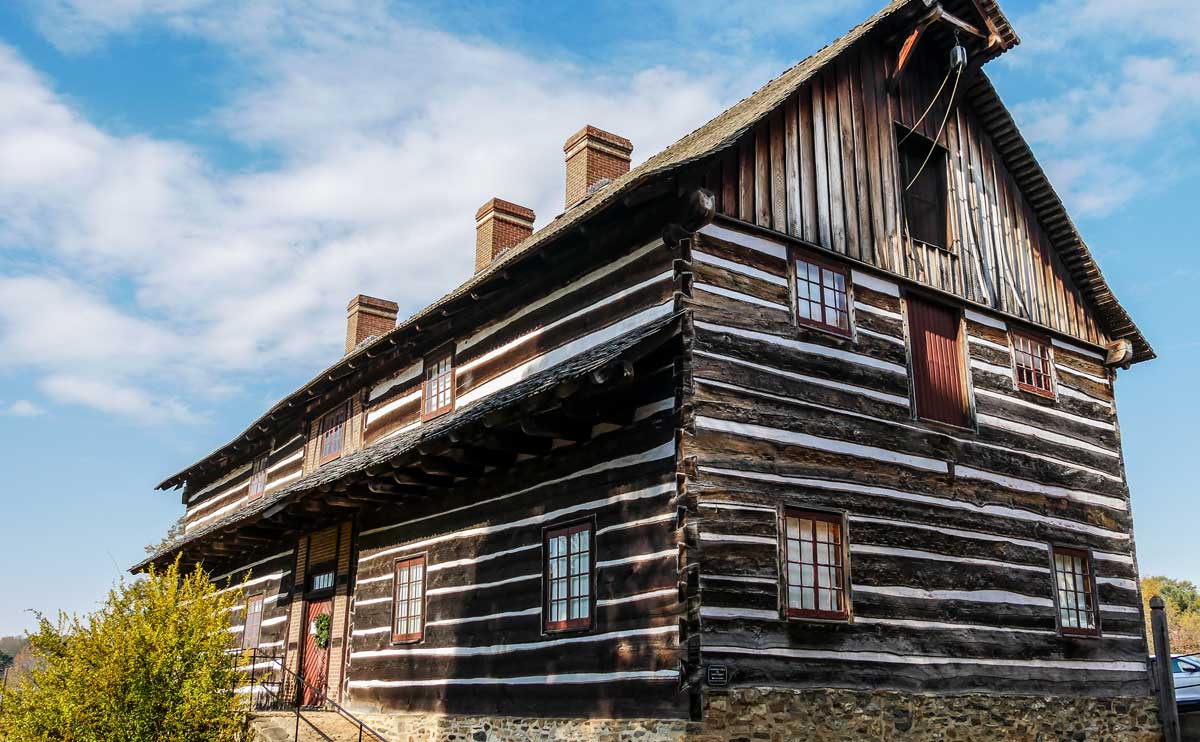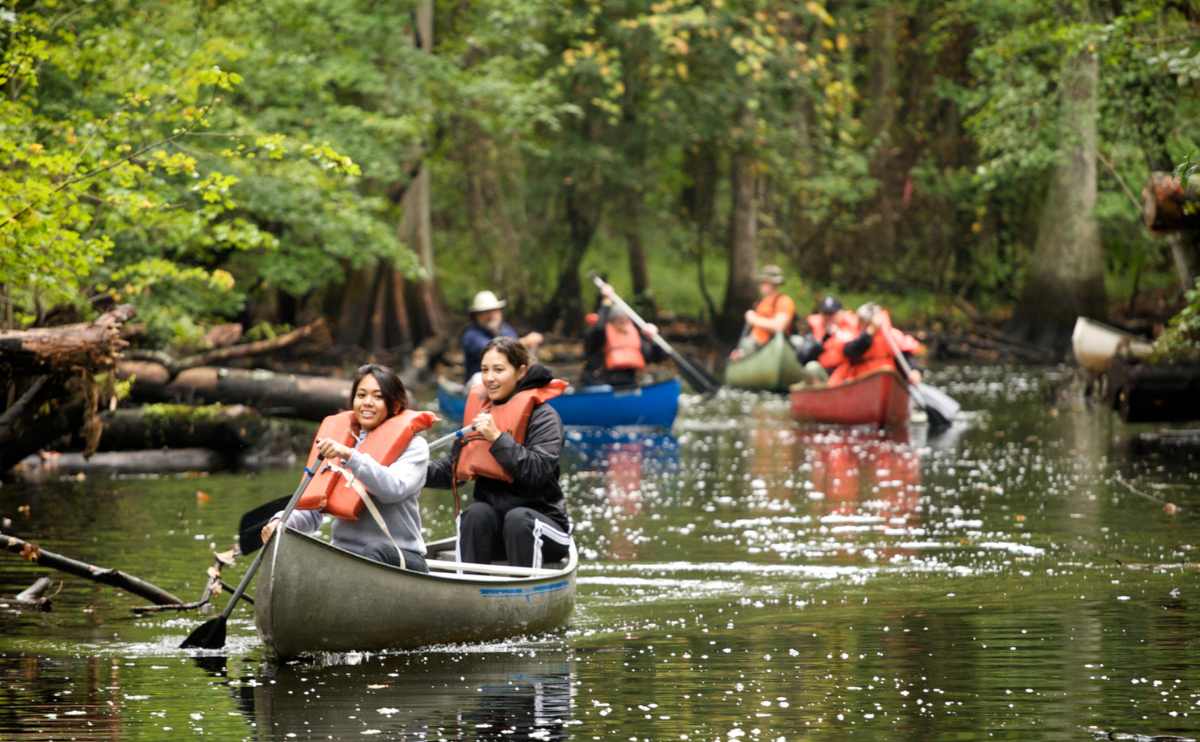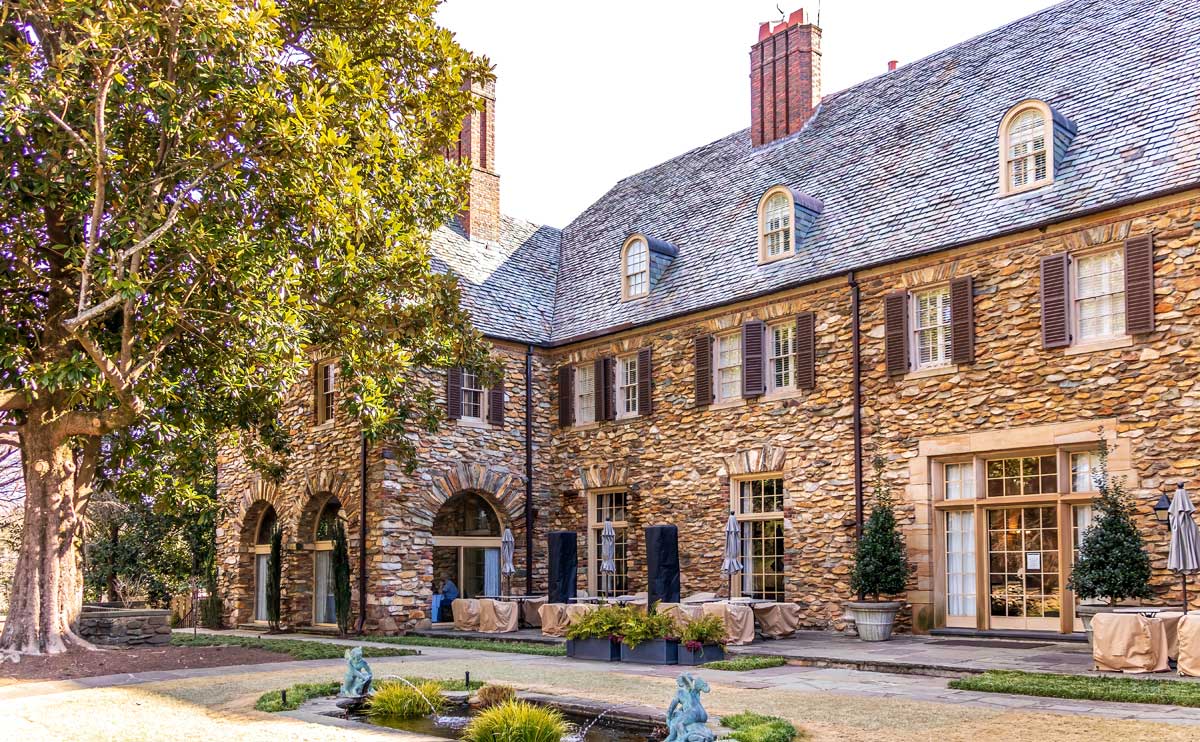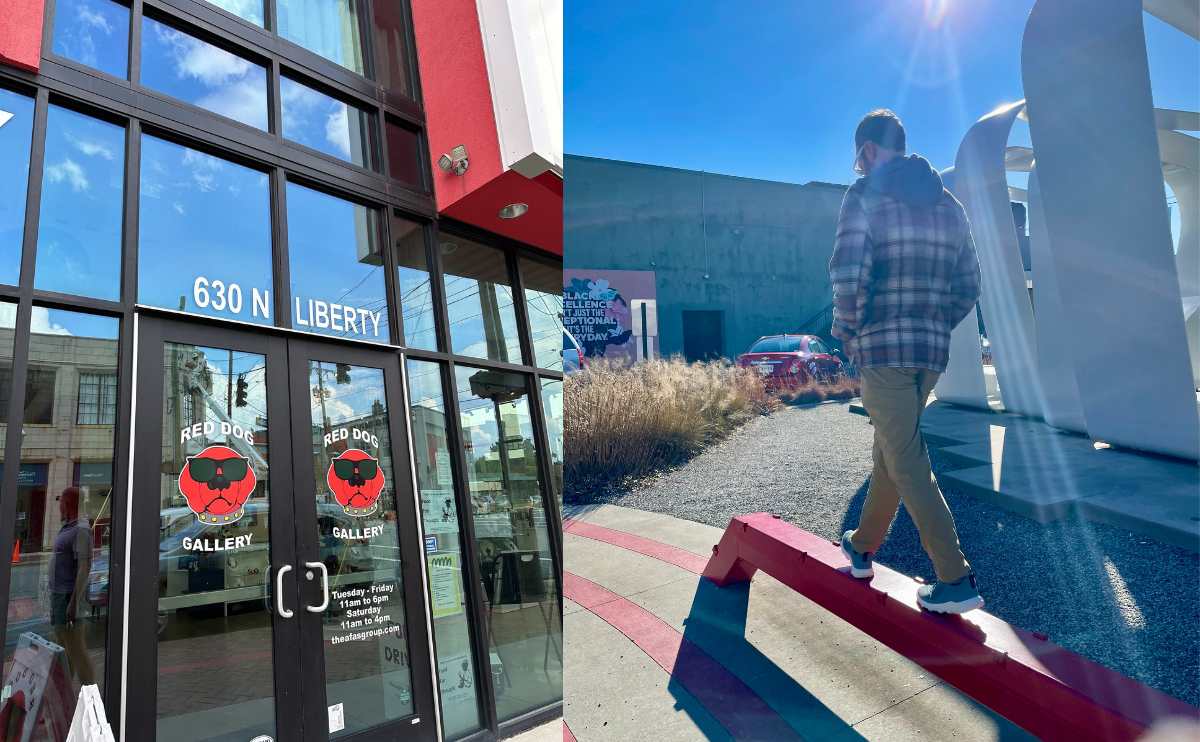To keep the lights on, we receive affiliate commissions via some of our links. Our review process.

Our fair city of Winston-Salem and its surrounding area is full of great local architecture sites. Did you know we have the “mother” of the Empire State building and a replica of Independence Hall right here in Winston-Salem, NC? Find out where Martin Luther King, Jr. spoke and the legend of the Salem Coffee Pot. Here is a guide to some of our favorite architectural sites. What would you like to see added to this list of notable local architecture?
- Wells Fargo Center
- Augsburg Lutheran Church
- Carnegie Library (First Presbyterian Church)
- Cedarhyrst in Old Salem
- Centenary Methodist Church
- City Hall
- Salem Coffee Pot
- Federal Building/Millennium Center
- First Baptist Church
- Goler Metropolitan AME Zion Church
- Graylyn
- Körner’s Folly
- Nissen Building
- R. J. Reynolds Building
- Sawtooth Building
- Shell Service Station
- Single Brothers House
- Trinity Moravian
- Winston Tower
- Winston-Salem Journal
- Young Men’s Christian Association Building
- Zevely House
- Historic Hotels
Wells Fargo Center

This iconic domed building is currently the tallest in Winston-Salem and the tallest in the Carolinas outside of Charlotte, NC. It was designed by architect Cesar Pelli, who referred to it as his best building, likening it to a “rosebud ready to bloom.” Making use of local Moravian themes in his design, Pelli included the Moravian arch (dome and entrance) and the Moravian Star (marble mosaics in the lobby). It is the only granite-domed skyscraper in the world.
Augsburg Lutheran Church

Located in the West End neighborhood, Augsburg Lutheran Church is a Tudor Revival structure built in 1926 with very interesting stone detail . And the building has several windows from the late 1800’s, saved from the original church.
Carnegie Library (First Presbyterian Church)
211 W. Third St.
Built in 1903 as one of 10 libraries across the country from 1901-1917 with a grant from the Carnegie Corporation of New York, this Renaissance Revival-style library was closed in 1954 and is now part of First Presbyterian Church.
Cedarhyrst in Old Salem

Located in Old Salem, this Gothic Revival house is situated at the entrance to “God’s Acre” the cemetery of the Moravian congregation. Cedarhyst is the private office for the Southern Province of the Moravian Church and unlike most of Salem, is closed to visitors.
Centenary Methodist Church
646 W. Fifth St.
This was the original Centenary Methodist Church. It was designed by architect Albert L. West and was located at the corner of Liberty Street and Sixth Street. It was named so because its construction was begun in 1884, the centenary anniversary of the denomination in the United States. In the 1920s, the congregation joined with West End Methodist Church and built the present day Centenary Methodist Church (1920-1931) on West Fifth Street. It features a massive stone edifice, from designs by the New York architecture firm, Mayer, Murray & Phillips.
City Hall
101 N. Main St.
Winston-Salem City Hall is on the National Register of Historic Places. It was built in 1926 and is Winston-Salem’s only example of Renaissance Revival civic architecture.
Salem Coffee Pot

The enormous tin coffee pot at the entrance to Old Salem is of historical note. In 1859, Julius E. Mickey advertised his tin shop on South Main Street in Salem by erecting the large tin coffee pot out front. The extraordinary pot measures seven feet, three inches in height, and five feet, four inches in width. The coffee pot remained intact over the decades, despite neighborhood youths knocking it off its pole during many Halloweens, until the construction of Interstate 40 forced its removal.
In 1960, after the coffee pot remained in storage several years, Old Salem officials requested to display the coffee pot, but the location was a source of disagreement. In 1962 James A. Gray suggested placing it in its current location, on a small grassy island where Brookstown Avenue meets South Main Street.
Legend has it that a Confederate soldier once hid inside the Salem coffee pot to evade from Union soldiers. This may have occurred in April 1865, when a band of Stoneman’s Brigade under General W. J. Palmer marched through town.
Federal Building/Millennium Center

Built in 1906, the grand Neo-Classical Revival-style Federal Building (now Millennium Center) at the corner of Liberty and Fifth Streets, housed the United States Attorney, Deputy Marshall, Commissioner, IRS and the Post Office. Digital Forsyth classifies the building under Beaux Arts, as well as Graylyn. The Federal Building has been the site of films such as Leatherheads (2008) starring George Clooney, and Susie’s Hope (2013), among others.
First Baptist Church

The First Baptist Church was designed by architects Dougherty & Gardner and completed in 1925. Modeled after the famed Roman Pantheon, this example of Roman Neo-classical architecture boasts a domed ceiling and Corinthian columns. The beautiful spire rises 7 stories, or 140 feet.
Goler Metropolitan AME Zion Church
1435 E 4th St.
Built in Classic Revival style in 1924, Goler Metropolitan AME Zion Church, now East Fourth Street Baptist Church, is on the National Register of Historic Places. Dr. Martin Luther King, Jr. spoke here in 1964. It was originally East Fourth Street Baptist.
Graylyn
1900 Reynolda Road
This French Norman style manor is located beside Reynolda House and Reynolda Village. Graylyn was once the estate home of Bowman Gray, Sr. and his wife Nathalie Lyons Gray. Bowman Gray was the founder of Wachovia Bank & Trust and served as Chairman of the Board for RJ Reynolds Tobacco Company. Construction began on the home in 1928 and was completed in 1932. The home is comprised of 60 rooms and 46,000 square feet.
In 1946, Mrs. Gray gave the residence to the Bowman Gray School of Medicine of Wake Forest University. The estate served as a psychiatric hospital until 1959, when Gordon Gray bought the estate back from the Medical School and donated it to Wake Forest University. After a fire in 1980, the home was restored in 1984 by architect Edwin Bouldin, Jr.
Graylyn has been host to former presidents Gerald Ford, Jimmy Carter, Ronald Reagan, and George Bush among many other world leaders and dignitaries. Graylyn offers 86 guest lodging accommodations within the manor house, bungalows and cottages on the estate. Today, Graylyn features a golf course and plays host to weddings and other special events.
Körner’s Folly

Dubbed “The Strangest House in the World,” this 1880 architectural wonder of artist and designer Jule Gilmer Korner once served as his home and his design portfolio. The house is a cornerstone of the Kernersville Community. The home has seven levels and 22 rooms with 15 fireplaces. Tours available and this unique home is definitely worth seeing.
Nissen Building

Listed on the National Register of Historic Places, this example of Neo-classic architecture was built in 1927 by W. M. Nissen with funds from his Nissen Wagonworks family fortune, a company dating back to 1787. Nissen lived on the 20th floor of the building.
It was the first air conditioned building in the Southeast. Office tenants over the years included the U. S. Air Force and the headquarters for the Office of Flying Safety. The building is currently home to restaurants and condominiums, whose tenants enjoy the rooftop pool.
R. J. Reynolds Building

The original headquarters of the R.J. Reynolds Tobacco Company, the Reynolds Building is a 314-foot and 21 floor tall skyscraper. When it was built in 1929 by architects Shreve & Lamb it was the tallest building in the United States south of Baltimore, Maryland, and it won a national architecture award. Known locally as “the original Empire State Building,” the building is well known for being the predecessor and prototype for the much larger Empire State Building that was built in 1931 in New York City. Each year, the Reynolds Building receives a Mother’s Day card from the Empire State Building.
Although the building is closed to the public, its art deco details are worth a stroll by and a peek in the window at the art deco mural inside. Notice the tobacco leaf detail above the doorway in the photo. And if you’re interested in a notable investment in Winston-Salem’s history and future, this building is currently up for sale for a savvy real estate investor.
Sawtooth Building

Located on Marshall Street downtown, the Sawtooth building is easily recognized by its “sawtooth”-shaped roofline. Built in 1911 as a hosiery factory by Hanes Hosiery, as Shamrock Mills, the shape of the building along with many windows and skylights allowed for maximum sunlight prior to the widespread use of electricity. The building was named to the National Register of Historic Places in 1978. In 1982, it became home to the Sawtooth School for Visual Art, and is today.
Following a $7 million renovation and addition which integrated the century-old building with a new modern façade on Spruce Street, the Milton Rhodes Center for the Arts opened at the Sawtooth building. A highlight of the opening night celebration in Fall 2010 was a performance by singer Tony Bennett. Learn more about the Sawtooth building and its history.
Shell Service Station

Built in 1930 by R. H. Burton and his son, Ralph, this Shell station, in the shape of a giant scallop shell, is a representation of the literalism prevalent in some advertising during the 1920’s and ’30’s. The owners of Shell Oil Company hoped to attract customers through a series of shell-shaped service stations. At least eight of them were built in the Winston-Salem area, but this station at Sprague and Peachtree Streets is the only one remaining. Preservation North Carolina, an organization dedicated to the preservation of historic sites, spent $50,000 to bring the landmark station back to its original condition. The landmark now serves as a satellite office for Preservation North Carolina.
Single Brothers House

Located in the Old Salem Historic District, the Single Brothers House was completed in 1769. It was built to house the Single Brethren, or unmarried men, of the Moravian Congregation of Salem. The first portion of the Single Brothers House was designed by Friedrich Wilhelm von Marschall, in traditional European “fachwerk” style, which is characterized by half-timbered buildings with clay-tiled roofs. A brick addition was added to the south end in 1786, by master mason Johann Gottlob Krause. The addition housed craftsmen and their apprentices and trades shops. The building had a kitchen and dining room, administrative offices, and a Saal (worship/meeting area). The Single Brothers House was declared an individual National Historic Landmark in 1970. Tours are available to view inside and also hosts Old Salem business offices today.
Trinity Moravian

Located in Washington Park neighborhood, Trinity Moravian Church was completed in 1926. It is one of Winston-Salem’s few “360” structures. Located on a triangle lot, the back is equally as impressive as the front.
Winston Tower

Designated a Forsyth County Historic Property and listed on the National Register of Historic Places, Winston Tower (formerly the headquarters for Wachovia Bank as the Wachovia Building) was completed in 1966. The 410 foot tall skyscraper containing 29 floors is currently the second tallest building in the city. It has been called the foremost example of International-style architecture in North Carolina.
Winston-Salem Journal

The Winston-Salem Journal building was designed by Winston-Salem architect Harold Macklin to be a replica of Independence Hall in Philadelphia, in honor of the 150th anniversary of the signing of the Declaration of Independence. The three-and-a-half story Georgia Revival building has Flemish bond brickwork. The 12/12 sash windows have keystone lintels. The original entrance to the building below the Journal/Sentinal sign features an elaborate classical surround with Palladian windows above.
Young Men’s Christian Association Building
315 N. Spruce St.
The Young Men’s Christian Association building was built in 1927 by Winston-Salem architect Harold Macklin. (Macklin was also the architect for the Winston-Salem Journal building). The four-story Classical Revival-style brick and limestone building served as the YMCA from 1927-1976. Limestone pilasters in the Corinthian order divide into three bays, centered over two main entrances. The entrances, facing Spruce Street, have arched openings with “Men” and “Boys” carved in the frieze over each entrance. The letters “YMCA” can be seen in the ironwork in the balconies above. The building now houses offices and apartments above.
Zevely House

The oldest house in Winston-Salem, the Zevely House was built in 1815 by Moravian cabinet maker Van Neman Zevely and was moved from its original site on Oak Street to the corner of Fourth and Summit Streets in 1974. It is currently Bernardin’s Restaurant and you can make a reservation to eat there for dinner.
Historic Hotels
Eager for more Winston-Salem building history? You’ll be amazed at how many lovely historic hotels, inns and other interesting locations reside just around the corner. They each have a story to tell, from the former home of the mayor of (Old) Salem, to the former manor house of one of our city’s (and Wake Forest University Baptist Medical Center’s) forefathers, the history they hold will enrich your experience during your visit to Winston-Salem, NC. Each are in a prime location in the heart of our city and offer easy access to downtown activities, restaurants and Old Salem. Learn all about them in our historic hotels article.
Tagged With: History, Moravian, Old Salem

